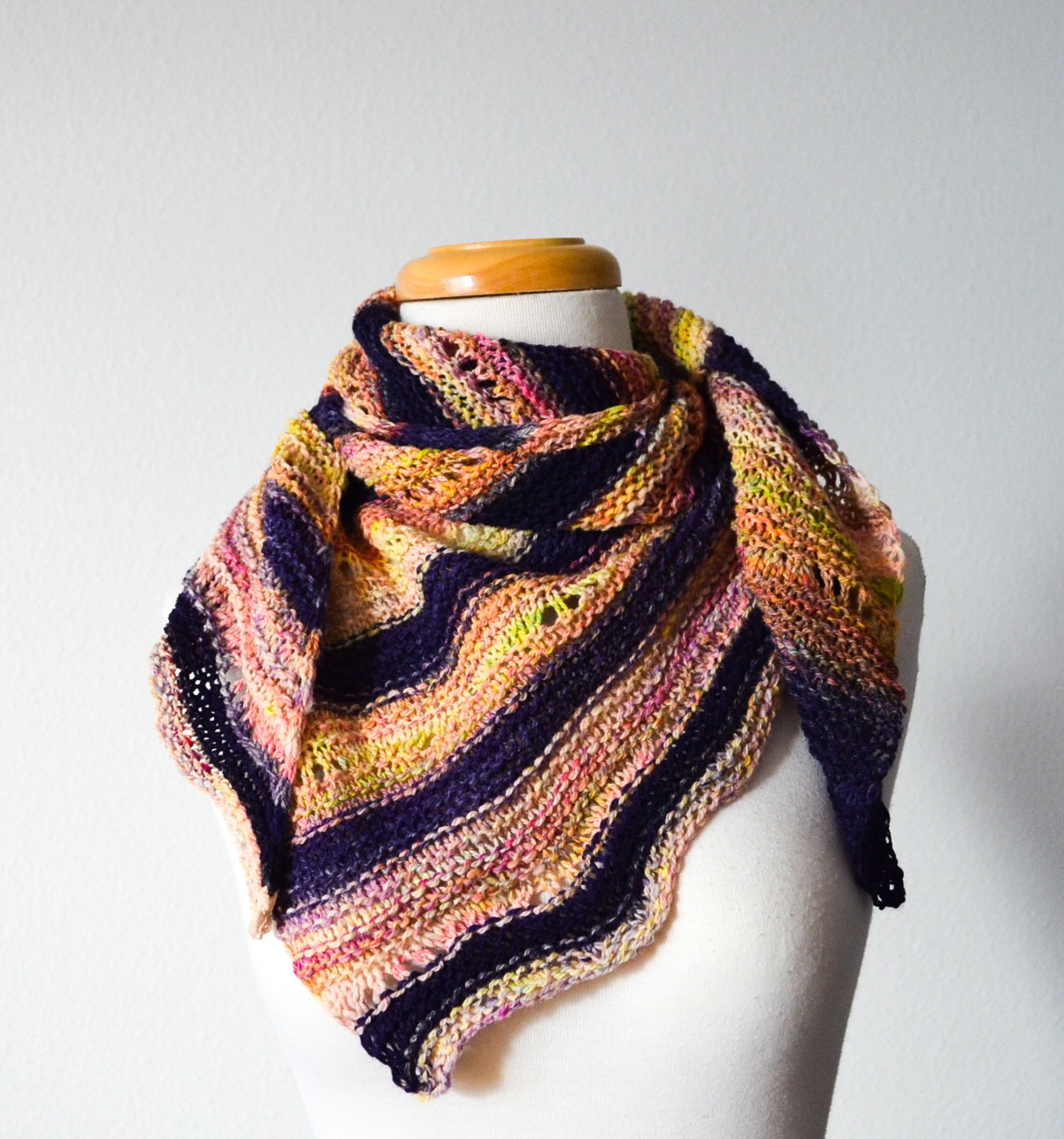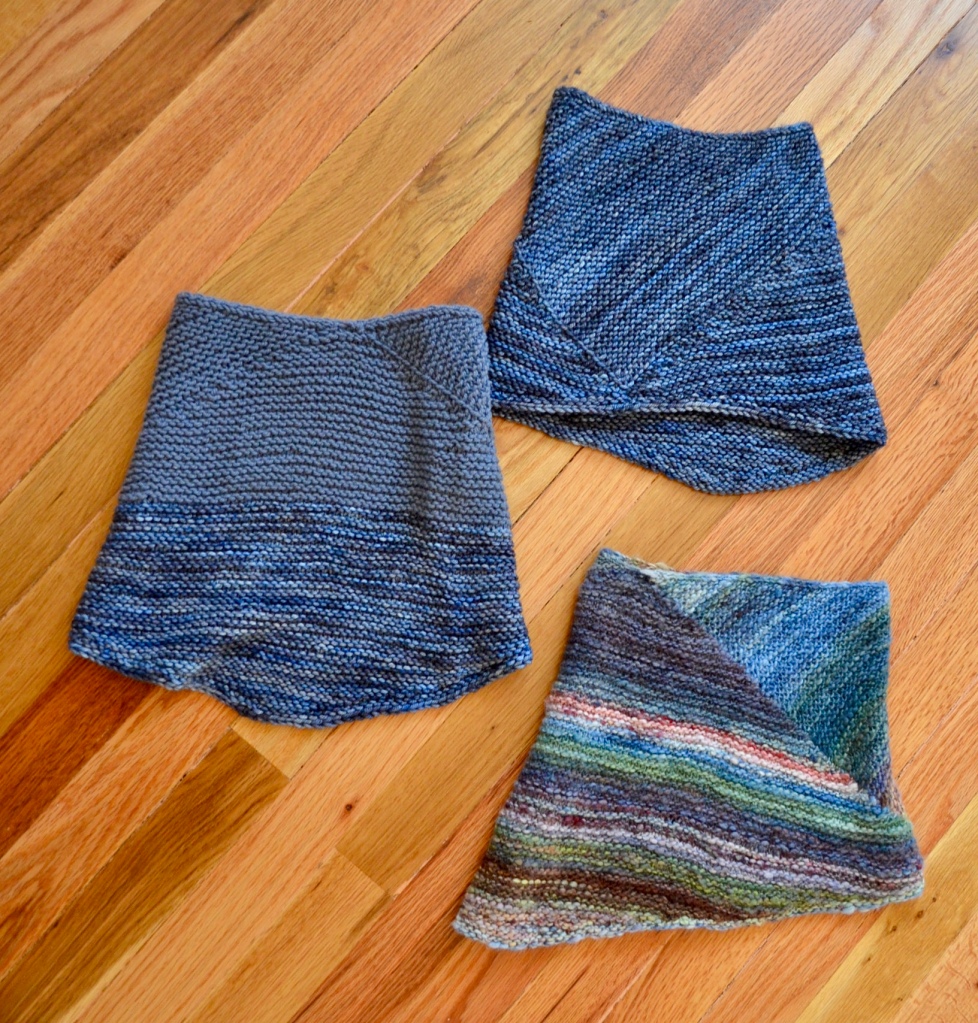
pattern
Dish Mat.
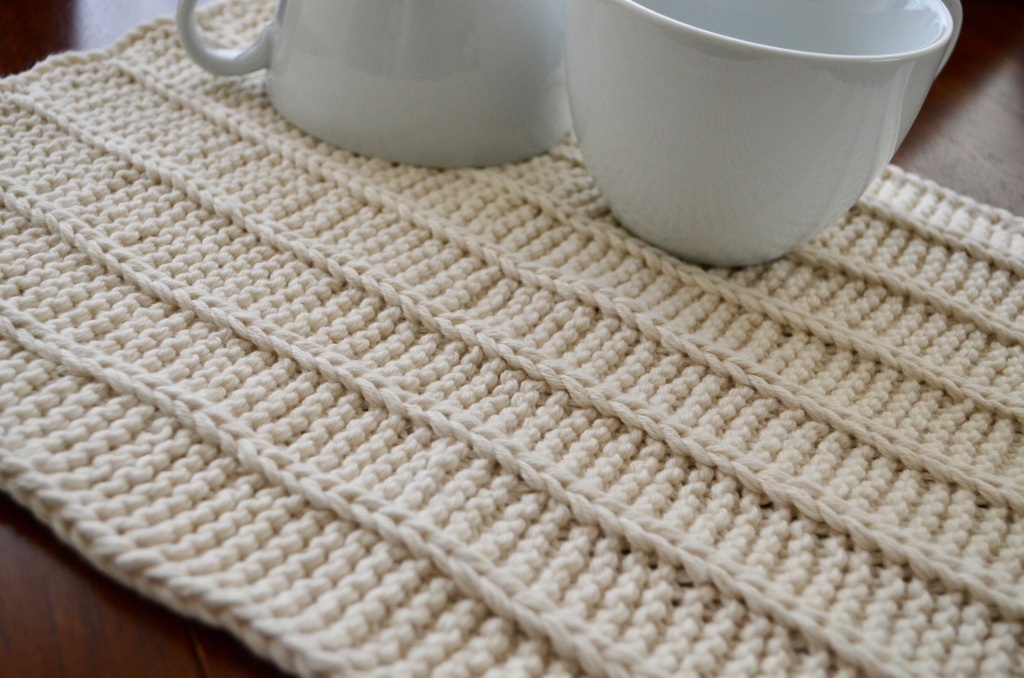
The Dish Mat knitting pattern is live! It’s pretty nice when it’s done, but to be honest, I find the braid technique a little tedious; if I want to move forward with my hilarious scarf version of this (called, obvious, Dish Mat Scarf), I’ll have to find a way to make them a little more tolerable. I’ve already got one option, so it’s looking at least somewhat promising.
Trinity Lace Cowl!

Obligatory Trinity Lace cowl promotional post! It’s a cowl. I would knit it again, but maybe in a bulkier woolier yarn. The owlfeather look of this yarn always appeals to me, though, and I like the way it highlights the lace panel a bit.
add to cart(This is probably going to be Trinity Lace aka Trinity Stitch cowl, since it turns out there is another Trinity Stitch cowl. It’s a different trinity stitch, though, and the designs are very different. It just makes it easier to link up your projects with the pattern page if I change the name.)
a set of rules for how not to court a yarn mfg.
I didn’t even post about the Columnar Jointing Cowl! There’s a columnar jointing cowl. It goes with the hat.

The sample is made from a bulkier yarn (Lion Brand Scarfie), but it could be knit at the same looser gauge in the same worsted yarn you use for the Columnar Jointing hat, in order to get a better match. It would also look neat in a bulkier luxury yarn; I’m really anxious to knit it or one of its companion pieces in something like Malabrigo Mecha or Rastita. It’ll look amazing, but it will also increase the project costs by quite a bit.

While I like (obviously) how the cowl turned out, and generally like the I get results from the yarn, which I’ve purchased several times, I have some wild mixed feelings about buying synthetic yarns. My yarn-snob qualities are kind of all over the place—I like luxe yarns, and if I could, nearly all my yarn would be madtosh and malabrigo and other fancy things I’ve never even tried yet, but I have learned that there are good-quality acrylics! You cannot really knit a baby a sweater from your favorite sturdy sock yarn if you want the baby to like wool, because that yarn is not soft and wears like iron, and babies get the soft sock yarn! Most big-box craft stores carry at least one decent 100% wool, and stitch patterns really pop in that Patons Classic blue-green color.
And the main thing, lately, is expense: if I need to knit a prototype and can do it for $12 or $31, and the longterm goal is to make money and continue to make new designs so the project itself is sustainable for me, it can be very hard to justify that extra $19 (usually plus shipping). I have a lot of basic wool, so I’m mainly using that and not often buying anything new in the first place, but not very much that is soft enough to recommend for cowls.
But at the same time—dude, I won’t buy a fancy-camping performance fleece jacket anymore because of the microplastics I know it’s gonna shed; I wanted a couple of cheap sweaters (one was a tiny moss stitch in a dark green; it was nice) last spring, as they would have fit with the decent minimalist wardrobe goal, but I think they were mostly acrylic and I could, you know, knit one almost as fine, and at least 75% less plastic,* if not all-wool and completely biodegradable. My wardrobe incorporates a lot of wool, all year round; I darn small holes in my hiking socks—and while I’m doing all that, and feeling massive guilt because I bought two skeins of pretty plastic yarn that will suit someone with a wool sensitivity really well, someone else organized a yarn bombing in a local park, and basically probably outdid my lifetime footprint of throwing acrylic microbits out into the world specifically via yarn over the course of a weekend.
(I also feel bad for not wholeheartedly liking yarn bombing, but reader, it made me feel really odd and slightly embarrassed, like someone will see me walking the dog and looking stunned and be like AHA YOU DID THIS YOU ARE ONE OF THE YARN PEOPLE. Some of it—a lot of it—was really well-made, but I guess in the end I just do not like the medium; seeing a lot of acrylic yarn on a tree gives me Feelings, but probably not the right ones, probably not the intended sense of whimsy. After three weeks, once they’re gritty and a little melded together, do you pry those really good grannie squares off a tree and make a blanket? If it has to be on a tree to be art, is it still art when some kid rips it down? Those bench-leg socks are very cool, but dost thou even have a dog, bro? Because oh man. I didn’t let my dog, but when you take the installation down, please, please wear gloves.)
So I’m knitting about three acrylic or acrylic-blend cowls this year for sample purposes, and feeling very keenly aware of my own hypocrisy. The projects almost fit my sense of justification—there are people who don’t want or use wool, so this pretty acrylic would totally make sense for them! And I’ll do a sock blend for my own personal use because the socks will last better, for example. I’m not to the point of living in a cottage with 100% wool handmade sweaters and all-wool socks that I darn every season; I am definitely not pure or to the goal or even sure what the goal is, yet. And for those who don’t turn into a self-questioning mess and like acrylics, one treasured handmade acrylic cowl you’ve done yourself is so much better than buying six not-quite-right acrylic pieces over a season.
In the end, this allows me to finish my work now, when it needs to be done. If the designs go over well enough to allow for a winter yarn purchase for the next things, I’ll make some dramatically different yarn-choices. But for now, I’m pretty self-aware, and not too well-cushioned by how at least I’m making accessories; I was never really in the market to buy a bunch of mass-produced acrylic scarves this year anyway. This increases my tiny plastic particles responsibility; it doesn’t keep it neutral or reduce it.
In conclusion, that’s how you alienate Lion Brand! Hooray!
*My personal favorite sock yarn really is Patons Kroy, which is like 75% wool, 25% plastic, and not soft, but pretty durable. I have some socks I knit from it. I have personal sweater-ambitions, too, but basically no time to fulfill them.
Picking Up Stitches on a Wrongside Row in Mouse Army Patterns.
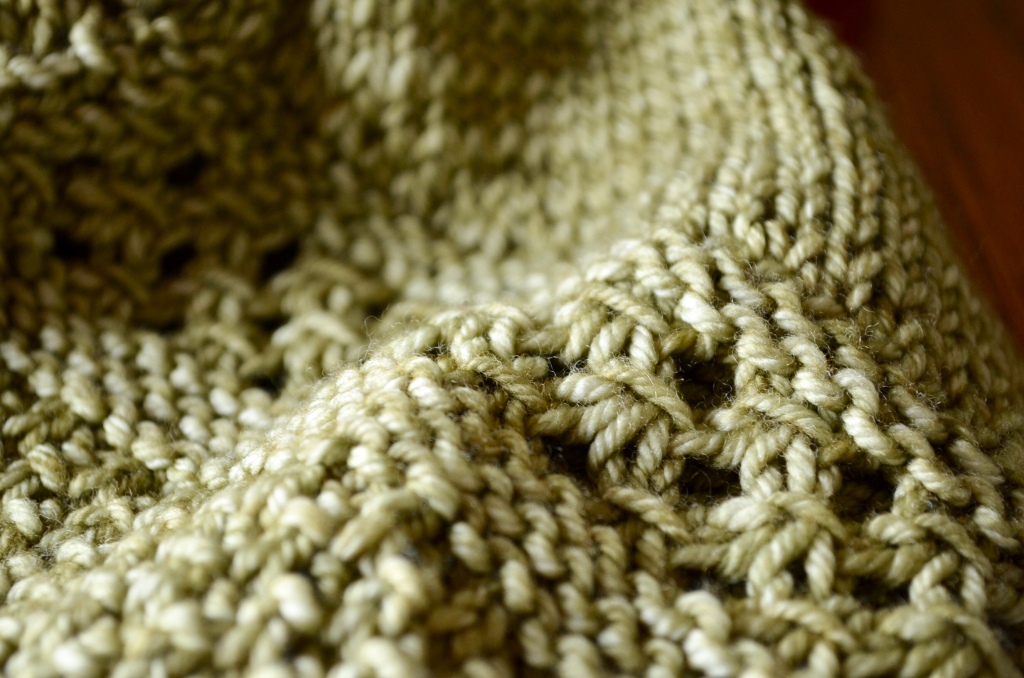
So, it’s been a while.
But I haven’t been entirely letting the grass grow under my feet, and I have a series of patterns almost ready to release for Fall 2019.
They’re tangentially related in a way I like, and I’ve noticed, as I apply finishing touches (and entirely new schematics in one case, because the original seemed to state that the circumference and the flat-measured half-circumference of a hat were the same measurement), that several of them share a technique: picking up stitches.
Picking Up Stitches.
Picking up stitches is easy! After you’ve picked up a few, the points where you’re meant to pick up a stitch seem to stand out, and hooking a couple of new stitches from the bumps in a cable cast-on row feels—to me at least— repetitive and simple. To pick up a stitch on a right side (RS) row, just insert the needle-tip in the cast-on loop, pull yarn through, and leave this on the needle as a new stitch. It’s the same each time.
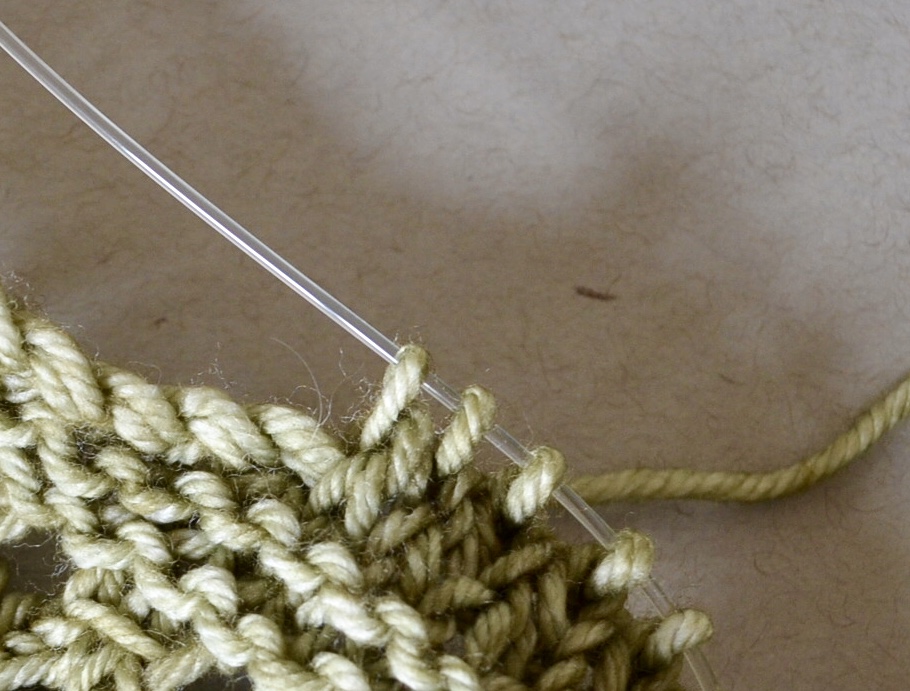
In fact, it’s the same always, at least for this handful of upcoming patterns. You always pick up stitches from the public side of the knitting, or the right side (RS).
The only thing that might be weird, the only thing that I think warrants an extra note and a whole post about it, is that these designs ask you to pick up stitches on alternating RS and wrong side (WS) rows—and you always pick up stitches from the right side, even when the row is a wrong side row.
To pick up stitches from the wrong side (WS), bring your needle tip through the cast-on bump (or the leg(s) of the selvedge stitch, depending on what the pattern asks; for a lot of these, you’ll be picking up stitches from selvedge loops) from the right side (RS). Pull the yarn through from back—the side of the fabric facing you, since this is a WS row—and leave the loop on the needle.

Do the same for the next stitch—or as many stitches as the pattern calls for. This is the same each time, too.

Picking up stitches from the public side of the work keeps the little faux-seam of the pickup edge hidden, and makes the join on the public-facing side look smoother!
This note applies to lots of new work from me for the coming weeks, so I’ll try to append a list of designs that use this as they’re available.
*The public side of the work is the right side.
Arete 1.



Arete 1 is a new shawl pattern—a simple design to show off a good yarn, with ribbing to make it compressible and more wearable as a a scarf.
It’s a triangle.
It’s also a pretty decent shawl, with no gauge to check (knit it at a density that gives you a fabric you like) and easy customization (knit it any size).
Dog Days for the Dog Days; Template Scarf.
This is just a very quick update, but I’ve got two new patterns coming up this weekend—Dog Days 7 (headband) and Template (scarf).
Dog Days 7 was my hiking project for a little while; Template has a pretty strong movie-night feeling to it, for me, although I didn’t watch anything specific while working up the first sample. The yarn was a commercial core-spun, and seemed a little delicate to drag along to a drive-in.

REVERSO!

So, the latest pattern is REVERSO, which is a reversible square throw-blanket. It sticks with the idea of using up your yarn scraps (I used Patons Classic Bulky and Patons Classic Worsted, held double in the latter case so they’d match).
EDIT: It is free through Sunday morning, but if you’re reading this after June 3rd, there are still about 93 free copies of it, and those are available through the end of June if you use code “FreeREVERSO!” I’m honestly back and forth on whether this should be a free pattern altogether, because it’s a pretty simple formula—but on the other hand, it’s a pretty good pattern, and I’m not sure if the expectation of patterns being free is good for indie design or not, or if it’s both but needs cautious use.
(The blanket is very simple and fun to knit. I’ve finished one and started two others, though I’m about 25-30 yards short on the second and I can’t buy more yarn for a scrap blanket. I did, however, actually purchase actual yarn to make a full-size non-scrap blanket too, despite not being big into yarn purchasing right now, so I’ve got two projects going for this, even though the .PDF is done and published.)
The Garter Scrap Shawl.
Gather up your soft yarn scraps, coordinate the colors, and get ready for an easy go-anywhere knit! This bias-knit garter stitch shawl consists of two extremely simple lines of instruction, and about three stitches total. It’s a free knitting pattern, though it’s simple enough that you might think of it more as a recipe. Either way, I hope you enjoy!

The Garter Scrap Shawl can be knit in any yarn, at any gauge. My sample is shown in worsted weight, mostly Malabrigo Yarns Washted and Rios, in part because the surplus of loosely-related yarns and colorways left over from the Dog Days series is really what inspired this project. (It’s also the reason I wanted to share it with you—it ends up being a pretty nice-looking simple shawl.) But it would look brilliant in light sock yarns, too, and a finer-gauge project would make a better travel knit.
Materials:
500+ yards of miscellaneous scrap yarns. (The sample shown took about 700 yards; the result is a nice big blanket shawl that weighs about 338g.)
1 long circular needle in US7-8/4.5-5.0mm, or size needed for gauge, or size needed to suit yarn.
Tapestry needle for weaving in ends.
Gauge:
Gauge is the great unknowable. You can knit this at any gauge; please choose needles that give you a fabric you like with the yarn you’re using. (Garter will expand a lot, though, so that’s something to keep in mind.) Gauge in the sample shown is 16 sts and 36 rows in garter stitch before blocking.
Measurements:
Knit until shawl reaches desired measurements. Sample measurements are shown in the simple schematic below.

Abbreviations used:
k—knit
m1r—make 1 right.
p—purl
(I really wasn’t joking; there are three stitches, if you count the increase as a stitch.)
RS/WS—right side, wrong side.
sl1–slip one. Sts are generally slipped purlwise unless otherwise specified.
st/s—stitch, stitches
Begin Work.
Using the cable cast-on method, CO 4 sts.
Row 1 (RS). sl1, k remaining.
Row 2 (WS). sl1, p1, k remaining.,
Row 3. sl1, k to last 2 sts, m1r, k2 (1 st inc) 5 sts.
Repeat Rows 2 & 3 until shawl reaches desired size, finishing with a completed WS row. The bindoff edge is going to be long. Please make sure you have enough yarn left to work the basic bindoff: sl1, k1, psso, [k1, pass previous st over] until all sts have been consumed. Weave in ends and block lightly.
Gratuitous Notes:
- If you’ve got enough yarn to equal about 2.5x the current length of the (non-compressed) current row, it should be enough to knit a complete row.
- When changing yarns, change them on the right side of work to avoid dotted-line garter stitch effects on the front. It is a shawl, so I mean, the reverse side is probably going to show, but if you like having a side without any dotted-line stripes, this is something to keep in mind.
- If you’re working with small scraps, and don’t like weaving in ends, consider using them in as part of a fringe instead. If you join all your new scraps on the RS, all the ends will be on the bottom right edge of the triangle.
- If you’re working with larger scraps or just dislike fringe, consider going completely crazy and weaving in a few ends as you go. This is sometimes regarded as playing with fire, but if you like how the shawl is coming along, it might be a good time saver, or insurance against spending an hour on the yarn ends when it’s finished.
There are lots of other ways to use your yarn scraps—you could use about 3.25 full skeins of Malabrigo Washted in coordinating colors, use this formula as the base for a temperature shawl, or knit it in a big skein of handspun.
BUENA ONDA 1.0
Buena Onda shawl (or shawlette, or kerchief, if you like—this is a truly a knit-it-at-any-(sensible)-gauge-in-any-(reasonable)-yarn project. (I’d advise 350+ yards, to at least get a shawlette out of it, but the pattern would work for a kerchief too, and of course, would work well as a larger shawl if you didn’t run out of yarn because of your yarn-optimism.)
